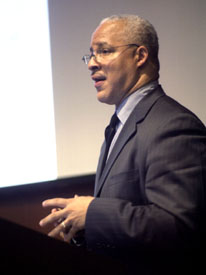Public Health Director Addresses Long-Term Care
 With age in today’s graying America comes the wisdom that long-term care needs reform. This “demographic imperative” isn’t lost on the director of the Illinois Department of Public Health (IDPH), Eric E. Whitaker, MD, MPH, who presented the 11th Annual Eckenhoff Lecture, “Long-term Care in Illinois: Financing, Regulation, and De-institutionalization” at Northwestern Memorial Hospital on May 25. Sponsored by Northwestern’s Buehler Center on Aging, the Eckenhoff lecture honors the late James E. Eckenhoff, MD, former dean of the medical school (1970â83) and professor of anesthesiology.
With age in today’s graying America comes the wisdom that long-term care needs reform. This “demographic imperative” isn’t lost on the director of the Illinois Department of Public Health (IDPH), Eric E. Whitaker, MD, MPH, who presented the 11th Annual Eckenhoff Lecture, “Long-term Care in Illinois: Financing, Regulation, and De-institutionalization” at Northwestern Memorial Hospital on May 25. Sponsored by Northwestern’s Buehler Center on Aging, the Eckenhoff lecture honors the late James E. Eckenhoff, MD, former dean of the medical school (1970â83) and professor of anesthesiology.
“We are all getting older,” remarked Dr. Whitaker, a faculty member at Rush Medical College. “I’ve been thinking a lot about this recently as I just celebrated my 40th birthday!”
Some 1.5 million seniors (65 and older) live in Illinois. Each year their ranks swell with aging Baby Boomers, who now or may some day require care on a daily or long-term basis. How these individuals will receive services adds to the complexity of redesigning long-term care in the Prairie State to better serve its constituents. “We all believe in long-term care reform, but we are not sure quite yet where we are headed,” admits Dr. Whitaker. “In a sense, it all comes down to money and who will pay for the care.”
Illinois has approximately 1,200 long-term care facilities serving more than 100,000 residents, from the young to the elderly. The state spends $1.75 million in an average month for the care of some 56,000 recipients receiving services in nursing homes. More than 750 of these facilities are eligible for Medicaid, with about half receiving funding. A big driver of how long-term care is covered, Medicaid pays for 63 percent of the costs of caring for current nursing home residents, according to Dr. Whitaker, whose department oversees the licensure, regulation, and inspection of long-term care facilities in Illinois.
Compared with the national average of 52.3 beds for every 1,000 adults older than 65, Illinois has available 74.2 beds, with 6,000 Medicaid-certified nursing home beds in the entire state. However, many of those beds sit empty, with facilities receiving Medicaid funding experiencing an occupancy rate of 82 percent. Some nursing homes have gone to extreme measures to decrease their vacancies. Stories about facilities that have resorted to filling empty beds with ex-convicts including sex offenders have appeared in the media, Dr. Whitaker noted.
“Occupancy in nursing homes has declined in the past 15 years,” continued Dr. Whitaker, who with other policymakers is hoping to shift the emphasis on traditional long-term institutional care to alternative services. “Our goal is to keep people in their homes and communities as long as possible, focus on health care outcomes, and have Medicaid help pay for preventive services.”
The IDPH, for example, has sought Medicaid waivers for supportive living arrangements that provide independent settings where older adults can reside with others. In 1999 Illinois opened the first such facility in the state. “Now are 44 are operating and certified by our department,” said Dr. Whitaker. “So there is a demand and a lot of opportunities for these types of facilities.”
The IDPH director also cited the success of community care and homemaker services that support seniors in their homes. These programs help them avoid premature admission to nursing homes. Of the population using these more progressive models of long-term care, 65 percent are 75 and older, more than 75 percent are female, 57 percent live alone, and 66 percent receive an annual income of $10,000 or less.
Several initiatives are being considered to improve the long-term care structure and shift it from facility- to home-based care. Proposals call for expanding career ladders and living wages for certified nursing assistants to help curb an industry shortage of professional care workers due to high turnover and job burnout. Reformers would also like the increased development of short-term care facilities that would rehabilitate and return seniors to their communities. Other plans seek to encourage family- and resident-centered care models as well as provide more consumer-directed care.
Dr. Whitaker suggested that partnering with private industry could help finance some reforms, but it won’t be inexpensive. “Restructuring long-term care will be an enormous task and cost a fair amount of money,” he concluded, “but the time is right and we [who advocate on behalf of care for seniors in our state] are the people to do it.”






